Dum ven�?ris was the constant call of a medieval responsory asking God for light: “when you come ... when you come and judge righteously, then you will give us light.” It was an invocation of expectation.
In this time stricken by crisis and virus we are called to deep cogitation, even in the field of memory and artistic culture. And here is the ideal leap. In early April 1520 Raphael died suddenly, to the dismayed amazement of the world. On that Easter the funeral bed was composed for the body of the supreme artist, and at the head of the bed was placed the great canvas of the marvelous Transfiguration, which had just been painted. The commotion was enormous. The coincidence between the making of the greatest masterpiece and the sudden departure of the genius indelibly marked that month and year. Even the recent exhibition on Raphael at the Scuderie del Quirinale started from the momentous moment of Sanzio’s death.
If we were to look again at the great panel, we could esteem its upper part as the extreme and supreme manifesto of the whole prodigious affair of the Italian Renaissance: nothing could have been more noble, lofty, measured, perfect, and sublime than Christ, a divinized man. Here Raphael gives us the incomparable stigma of the values of Renaissance humanism: classical, courtly, Christian. The trembling assigned by Bembo to Mother Nature(rerum magna parens), heartfelt that with Raphael’s death she herself might have died, gives us the measure of human capacity when through art she was able to translate those values into figures. And on the other hand, there is a kind of law (well known later to the Leopardi of theInfinite) by which the absolute itself generates disquiet. The lower part of the Transfiguration thus became the legacy of uncertainty that Raphael’s pictorial rise was forced to lay down as the “compitum aenigmaticum” in the history of art.
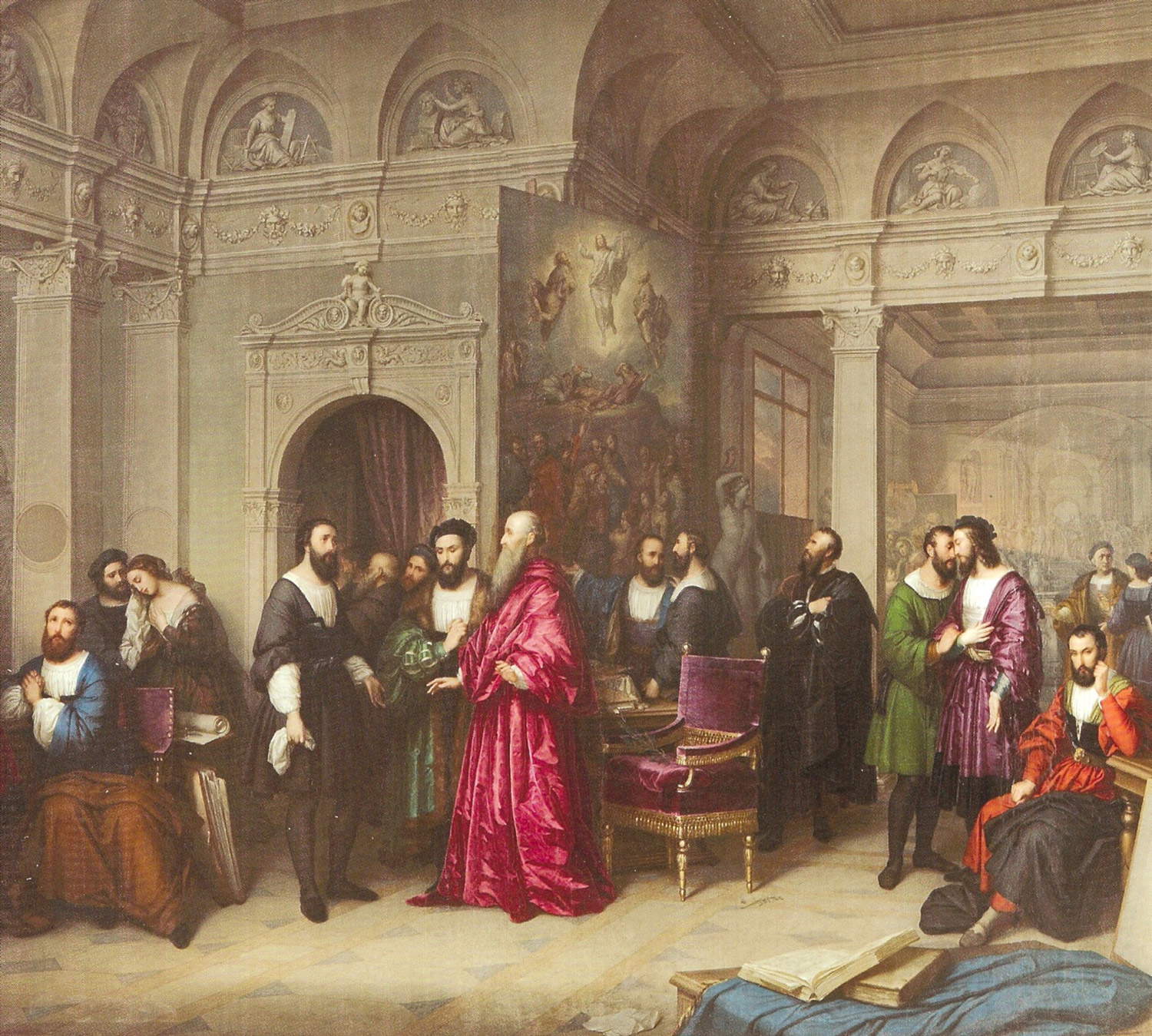 |
| Felice Schiavoni, Desolation in Raphael’s studio at the time of his death, detail (1859; St. Petersburg, Tsarskoe Selo State Museum). The newly finished panel of the Transfiguration is glimpsed. |
In the same days in which Rome and the whole of culture mourned the death of the Urbino genius, in a small town in the Po valley another painter was gazing at a newly plastered dome first hand, all hollow and bare, which seemed to be waiting for a pictorial dressing up there, above an entire recent basilica, inhabited only by the faint atmospheric glow. This was the newly completed ecclesiastical hall of the monastery of the Benedictine Fathers in Parma, finished after a complete reconstruction following a distinctly basilican and Renaissance design, with three naves and a transept. At the intersection of the two major spaces rose a dome, certainly “more Roman,” stimulated by the masterful prediction of the new St. Peter’s designed by Bramante.
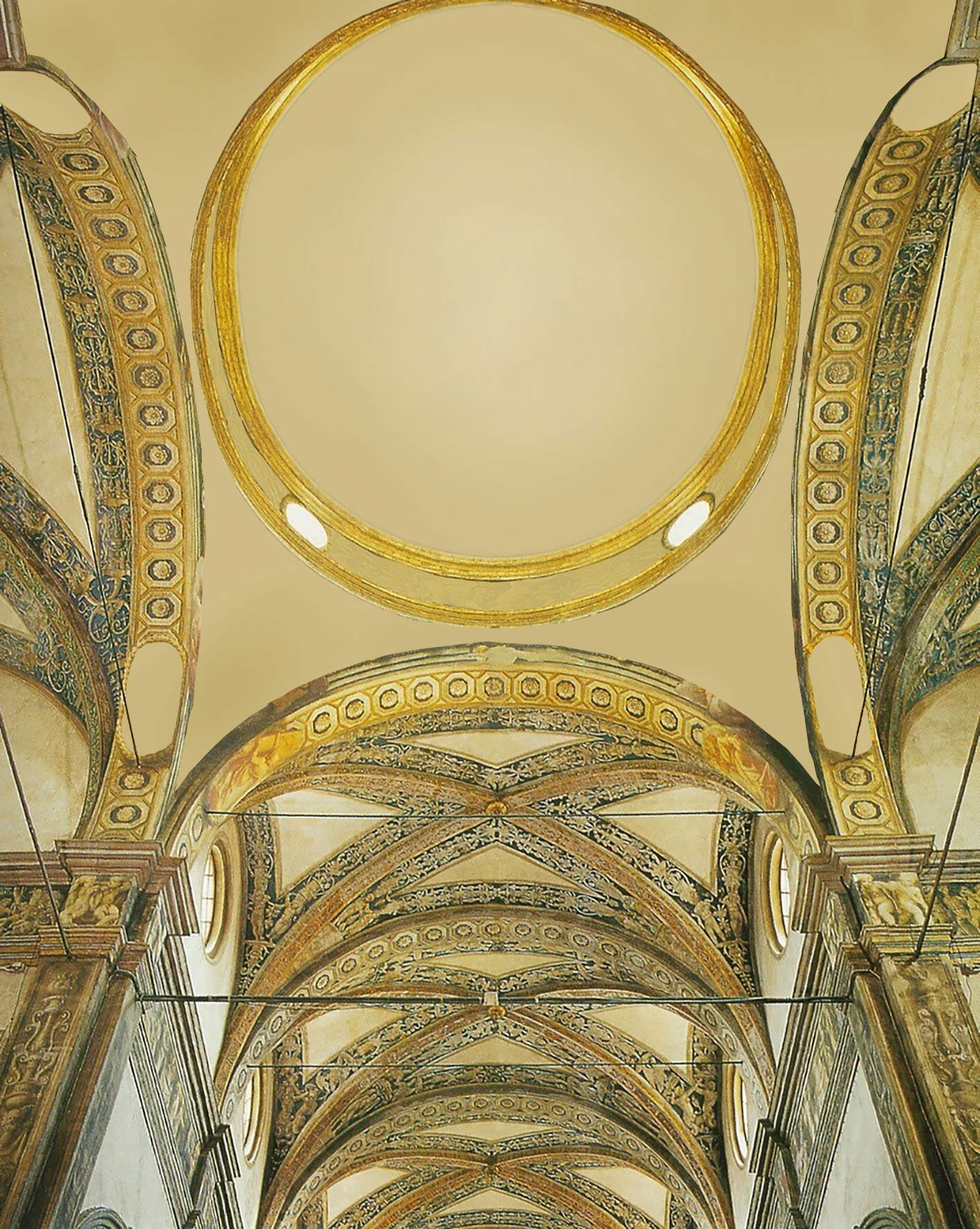 |
| The empty dome of St. John the Evangelist in Parma, as it appeared as soon as it was built. Photographic reversion by Giancarlo Garuti |
Much has already been written about Correggio’s resounding invention with respect to the concave, almost ovoid invaded dome that stood well walled up there, and even lacking a lantern to filter the light of the beautiful Lombardy sky into it. We all know of the painter’s inexpert negation of the material envelope and the shocking substitution ripping open the divine empyrean, open in infinitum and sprinkled with the golden light, which belongs to God alone. Here one can recall the illustrious and fascinating pages of Mengs, Quintavalle, Gould, Shearman, Morel and other famous authors. The scene, moreover, must be analyzed in its visual components: the haeteria and clouds, theapostolorum chorus, the tireless motile ferment of the childlike spirits; and of course the descending presence of Christ in human figure, surrounded by the infinite and unfathomable angelic depth.
Below them all, anchored briefly to the earth, stands the vigilant St. John who now catches with his eyes the longed-for call of his friend Jesus. Many things have been explained about this composition, so rich in emotion and meaning, as well as about the technique likely applied by Correggio, which involves the incredible wisdom of foreshortening along with the careful use of the astrolabe: the instrument of the heavens, as Geraldine Dunphy Wind illustrated in a memorable essay.
Here we would like to accompany the visitor to realize how the presential priority of the mystical scene the painter has assigned it to the imposing and physical lap of the Apostles. There is no doubt that the eleven bodies of John’s companion saints are eminent within that “locus intrinsecus” that we identify as paradise, which is thrown wide open to our world.
 |
| Correggio, Fresco in the dome of San Giovanni Evangelista in Parma. Vision from the east. St. John’s call to heaven. The cup was frescoed in 1520, the drum and spandrels in 1521. Note the array of naked apostles. |
We would like together to understand this particular choice. We know how from the ancient oriental icons up to the mosaics and frescoes of the Middle Ages the heavenly court appears many times all around the figure of Christ triumphant in the heavens; but the great mutation of the Renaissance had strongly humanized the relationship between the Lord and those whom He Himself had chosen for the propagation of the faith, from the Apostles to the holy witnesses, involving in this also the biblical prophets and patriarchs. We can see, therefore, how three brilliant protagonists of this new season have stretched out the crown of those whom we shall call the interlocutors of the Incarnate Word. They are: Leonardo, Michelangelo, Raphael. Ours is initially a brief formal research.
Since forms have their own genetics, a vital and binding bond that flows throughout the years in artistic exercises and is transfused (see the Vie des formes of the great Focillon), and since nullo homo, to put it in Franciscan fashion, can subtract himself from his own historical time and native land, here it is that Correggio’s creative outburst in the dome of San Giovanni Evangelista in Parma, in the years 1520-1521, also needs the relative spatio-temporal justifications, which are inevitable. But, since we are dealing precisely with forms, such dimensions, or characters, must be found in the earlier Masters and apply to the rising climate (which bears several names) of that multifaceted and brilliant phenomenon called the Italian Renaissance.
To digress, with an axiom we could say that “if no one could paint like Giotto before Giotto,” no one then after him could paint without his legacy. In the case of Correggio to only one name before Allegri we must substitute, as we have said, at least the three high ones of those who left unavoidable works between the end of the 15th century and the first two decades of the following century: Leonardo, Michelangelo, Raphael. Certainly the Stanza della Segnatura and the vault of the Sistine Chapel for Correggio, who arrived in Rome in 1513, were the strongest, most recent and indelible imprimaturs, given their epic symbolic magnitude. In them the 24-year-old painter from the north found, in addition to a series of impressive anagogical data, the register of the postures and faces of the “men of Christ.” In Raphael’s Dispute of the Blessed Sacrament, the upper assembly around the throne of Jesus offered him a quiet, if solemn, catalog of palatial and eminent males.
In the Sistine vault, by contrast, Michelangelo’s sequence of Prophets and Sibyls showed an alternating and subsulting roiling of spirits; but each of these isolated within the marble stipulations of its own scanno. Great examples certainly, but insufficient to be simply reported in any other context.
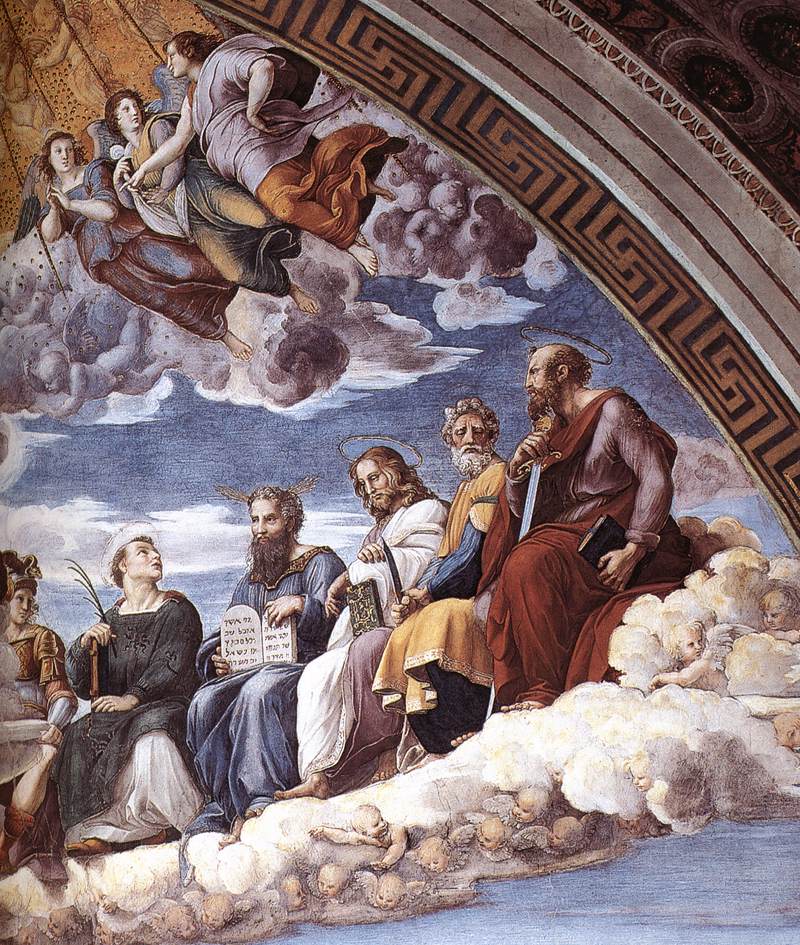 |
| Raphael. Frescoed detail from the Dispute of the Blessed Sacrament in the Stanza della Segnatura (1509). Here the figures around Christ are paludated and heedless of their majesty. |
 |
| Michelangelo, the vault of the Sistine Chapel. The figures stand within the mirrors of the open architectural members. |
 |
| Michelangelo. Frescoed details from the Sistine Chapel vault, the prophet Ezekiel (1512). The prophet Ezekiel and the prophet Joel, like the other biblical figures, appear restless and engaged in a mystery certamen. |
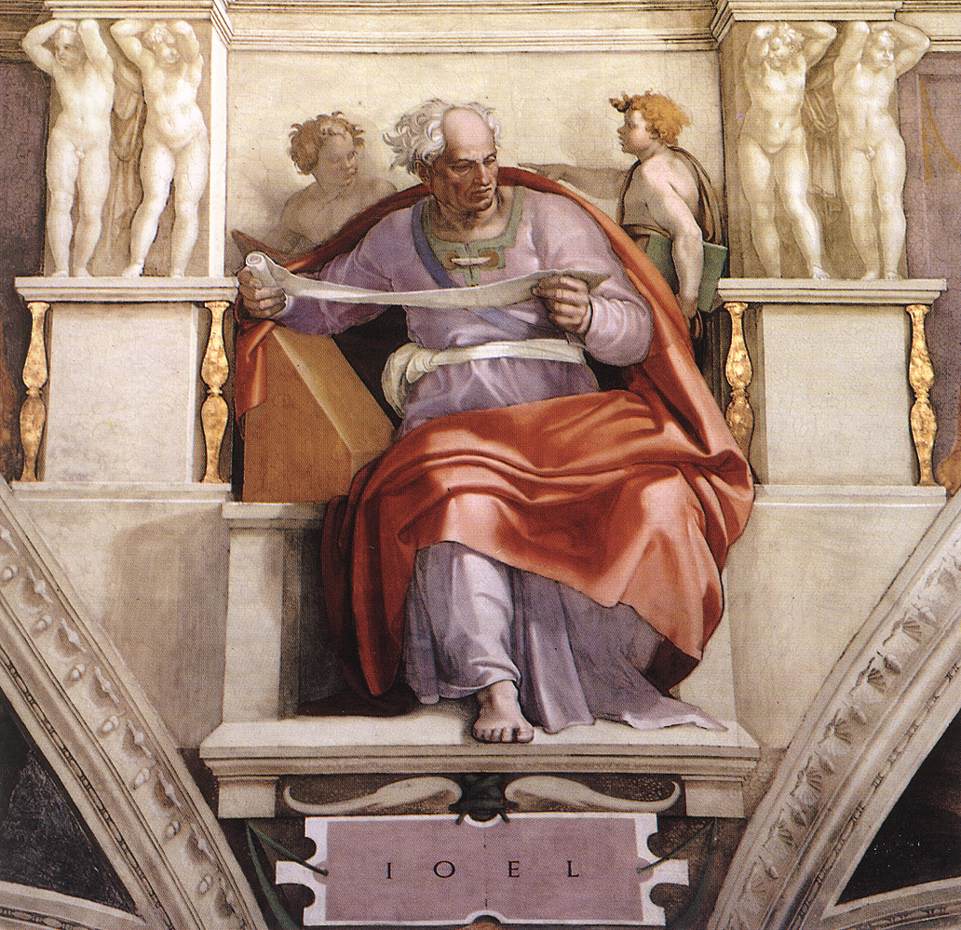 |
| Michelangelo. Frescoed details from the vault of the Sistine Chapel, the prophet Joel (1512). |
Insufficient we said. Here is the critical point: their overcoming! The finding on the part of the “painter of the north” that new flight that would lead to the certain subsumption of the highest notes of what has been rightly called “the Christian humanism of the Renaissance,” omitting altogether the simple imitation of a belt of spirits, which, in Correggio’s thought, cannot only stand, but must participate with evidence in a glorious and preteruman moment. So Allegri sets aside the Olympian eloquence of the Disputa, and if anything, in Santa Maria della Pace he takes intimate pleasure in the sinuous, ringed references of Raphael’s Sibyls, so serene and free. On the other hand, faced with the eternal texture of Michelangelo’s prophetic motions and glances on the vault of the Sistine Chapel (inalveolated within the most gigantic pictorial architecture of ordered and superb stones ever intended in the history of art) the young Antonio perceived the detachment from the divine intrision and the unreached bliss of the protagonists of waiting and redemption. A most important problem of expressive content.
At this point we must pin ourselves down to concern the intensity of Correggio’s youthful formation on the truthful escort of David Alan Brown’s (1983) basic thesis; we must go back to Leonardo and the intimate poignancy he was able to give to the characters of his researches, his notes, his paintings, and above all we must review the dialectical responsory of the Apostles-convites at the Last Supper in Milan (1495-1498), where each personal character is remarked and vibrates with an inner feedback for the momentous moment that is taking place. The great mural painting in the Dominican Convent of Santa Maria delle Grazie truly appears as an anthology of the motions of the soul that are addressed to Jesus, present, in a dramatic passage of his mortal life. Correggio understood its full intensity.
 |
| Leonardo. The Last Supper. A “sacred action” that takes place eminently within the souls of those present. |
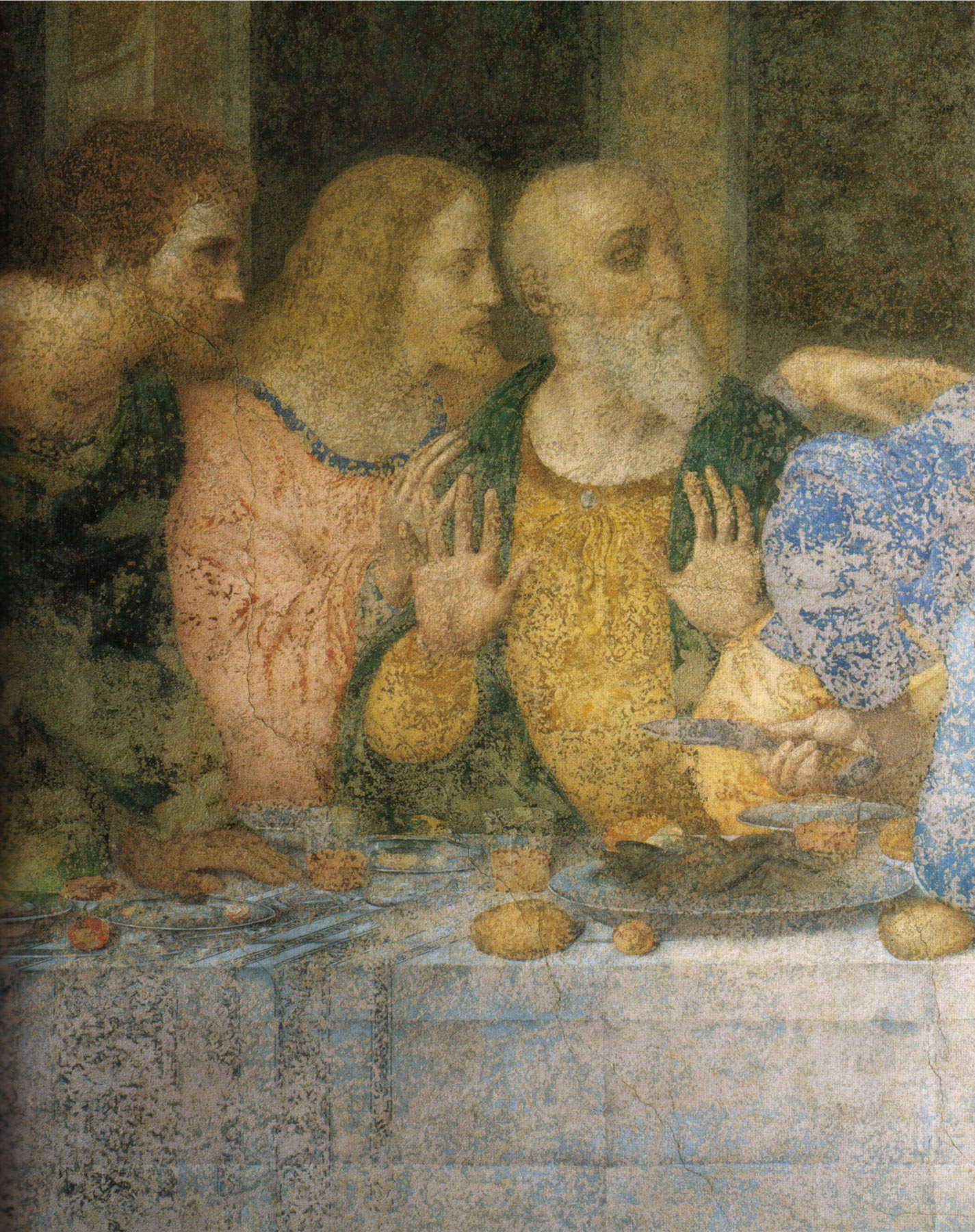 |
| Leonardo. The Last Supper. Apostles Bartholomew, James of Alphaeus, and Andrew. Faces and hands speak, revealing the restlessness of hearts and minds. |
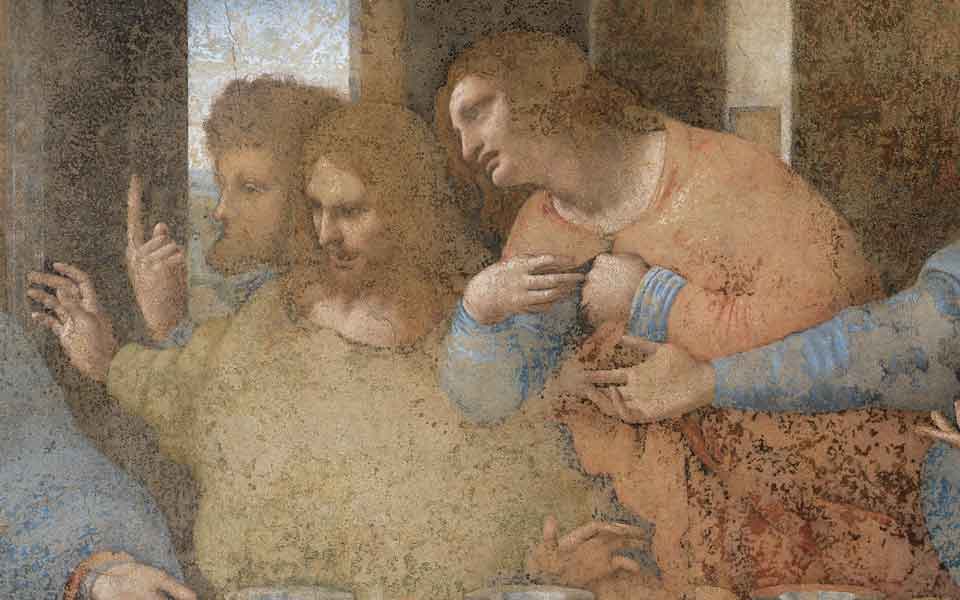 |
| Leonardo. The Last Supper. Apostles Thomas, James of Zebedee, and Philip. The anguish of the latter. |
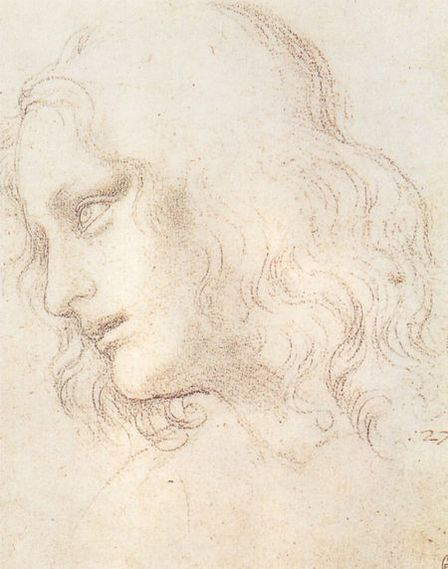 |
| Leonardo. Expressive research drawing for the Apostle Philip, the one who with extreme transport had asked Jesus, “show us the Father.” Here his trepidation. |
Cogitating on the dome of St. John’s, Correggio is brought yes to compose the action of the Evangelist’s encounter-call but, thanks to his theological training, he cannot fail to comprehend the whole divine epiphany that follows. The presence of Jesus is the presence of the resurrected, triumphant Christ, inhabiting the immense glory of heaven, and therefore the “place” that surrounds him must be that of eternal happiness, and of spiritual joy that supremely imbues those who accompany him. For the painter, it is a joy poured out in human, bodily presences, sublimated by the marvelous and calm status of the enjoyment of the beatific vision. Here, then, is the paradisiacal condition chosen by the painter, who shortly before had already stupendously resolved the Room of the Abbess, in the Benedictine monastery of St. Paul, with the revolving procession of innocent spirits within the Garden of Eden.
The great gathering of the Apostles on the clouds in the dome of St. John’s is similarly a mystical “convenerunt in unum” that is reified in the monumental figures of the Eleven, divinely called to welcome the elderly John in his transit to heaven, and that has a raison d’être (and thus appearance) in the pure if cyclopean presence of bodies. Presence here is being!
What then is the justification for this circuitous chorus, surrounded by the ethereal clouds but so powerful as to supplant all function, acts, doing? It is the immersion of human life in blissful eternity. Here the apostolic characters must not have expressions of anxiety or doubt, but neither of pompous satisfaction since all grace comes from God, and is not of themselves. Correggio adheres intimately to such balance, spiritual and mimicry, which obliges us to a high and committed critical feedback.
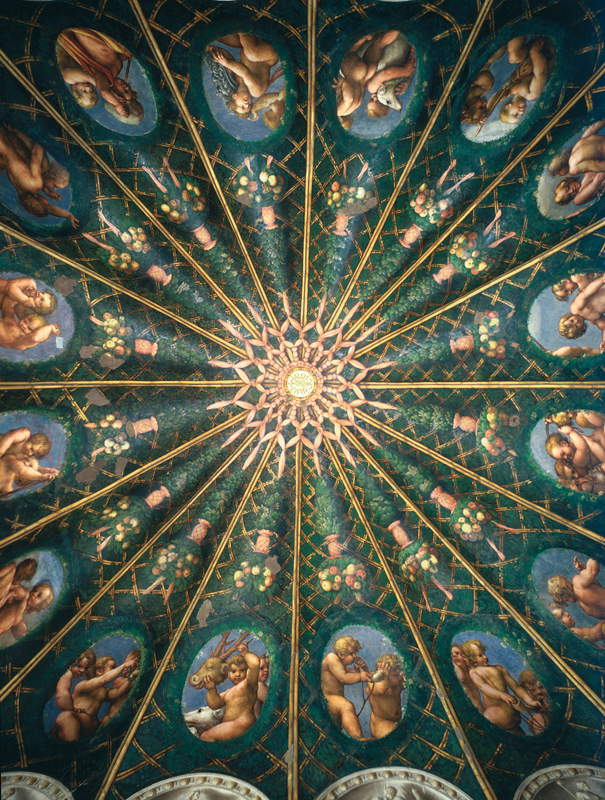 |
| Correggio. The vault of the Abbess’ Chamber in the monastery of San Paolo in Parma (1518), where indeed the “puerile decus” letifies the mystical garden of juicy fruits and raises the Hosanna pium. |
 |
| Correggio. The fresco of the dome of the Basilica of San Giovanni in Parma (1520) where we capture the imposing circuitous role of the Apostles, necessarily naked because they are glorious. Here Jesus calls St. John, placed under the clouds. |
 |
| Correggio. St. Paul, St. Peter in the center, and St. Philip. These figures are composed and self-conscious; they seem more addressed to the faithful over there, with exemplary, participatory postures and gestures. |
 |
| Correggio. Study drawing for the Saint Paul and Saint Peter. Leonardo’s own method is captured there, with a fluency of admirable inner emotion. |
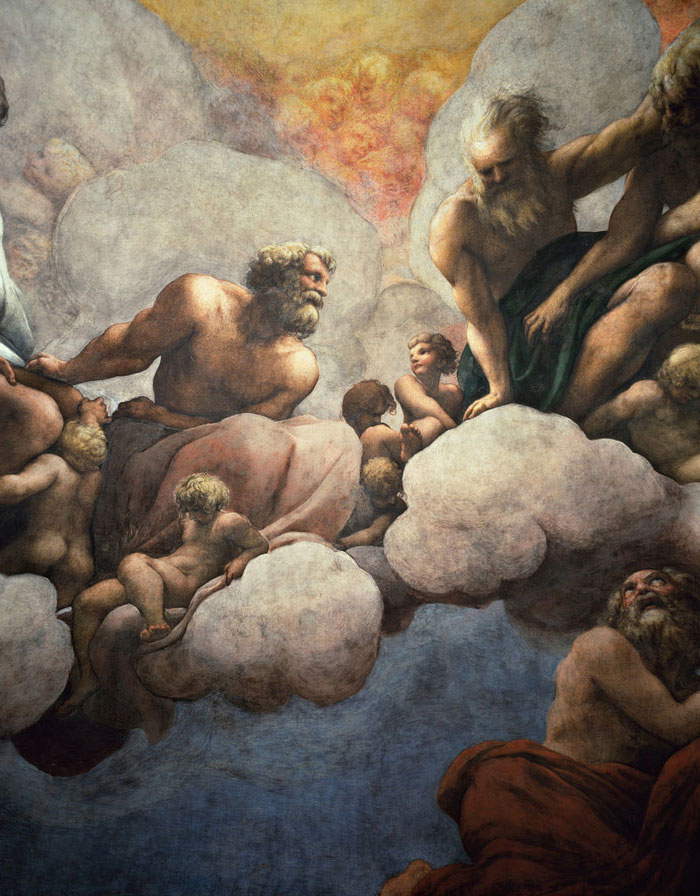 |
| Correggio. Saints Simon and Bartholomew. Beneath the clouds Saint John, who, on the last day of his earthly life, aims at the heavenly assembly. It is the closest connection between heaven and earth. |
 |
| Correggio. Apostles Thaddeus and James of Alphaeus, further to the right Thomas. Splendid pictorial passage where the supreme and participating serenity of the sanctified Apostles is captured. |
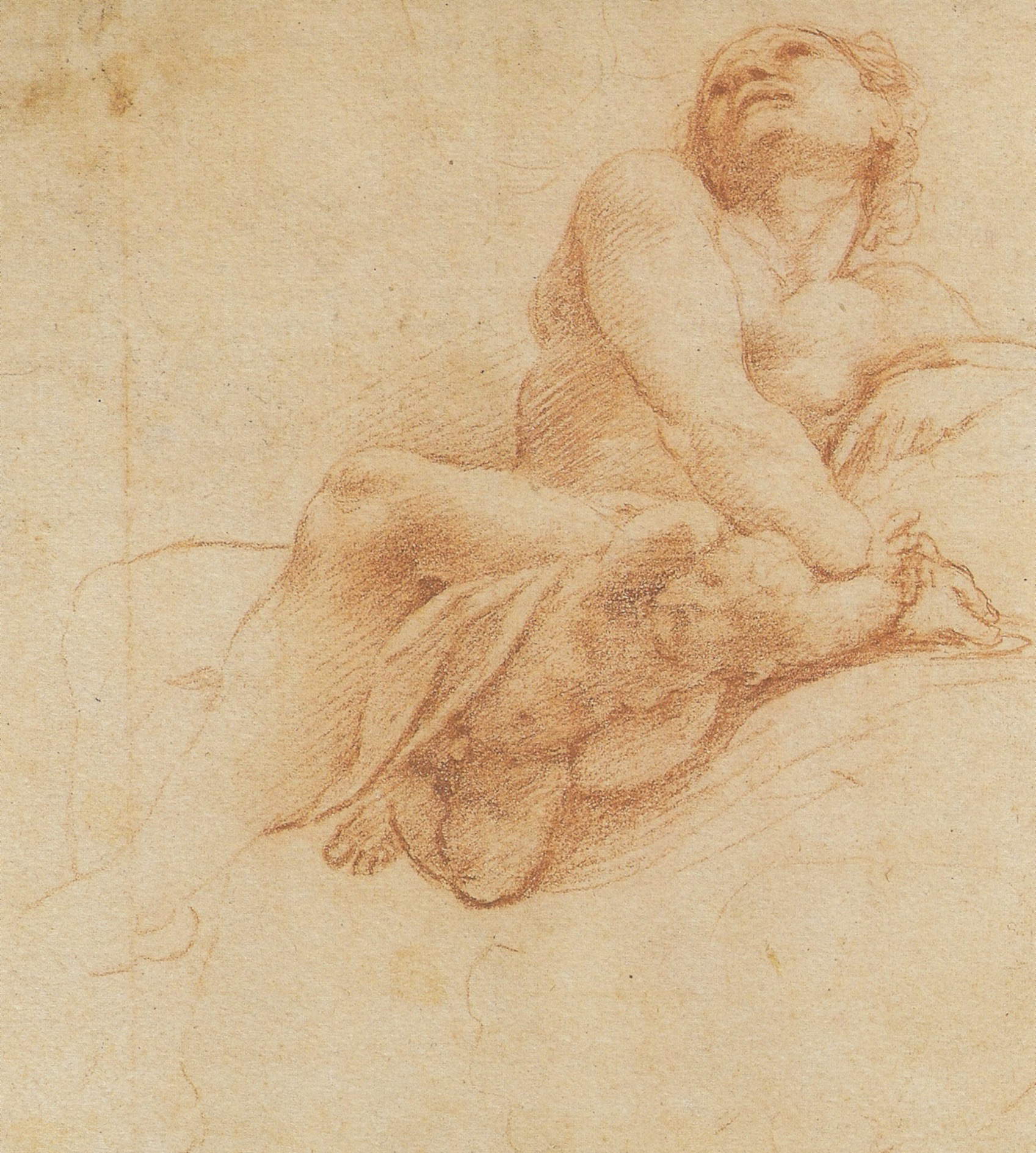 |
| Correggio. Drawing in preparation for the fresco of the dome of San Giovanni in Parma. An extremely musical study in the ecstatic abandonment of the Apostle facing the beatific vision. |
According to what St. Paul writes, Correggio is well aware “that the mystery of Christ lies shrouded in the silence of the eternal ages,” and that every human appearance of the Word is a parousia of love and glory. Thus he, the painter, conceives the presence of Jesus descending from heaven as an eternal act that implies the same infinite majesty of God. If we wanted to decrypt the scene of the dome in temporal, gradient order, we should logically place first St. John waiting on earth, and then from heaven the elevated coming of the other Apostles above him: at this point they form a crown of expectation, the most powerful, the most intense, the highest etimasia in the history of Christian art for the coming of the Word. They are the very throne of God !
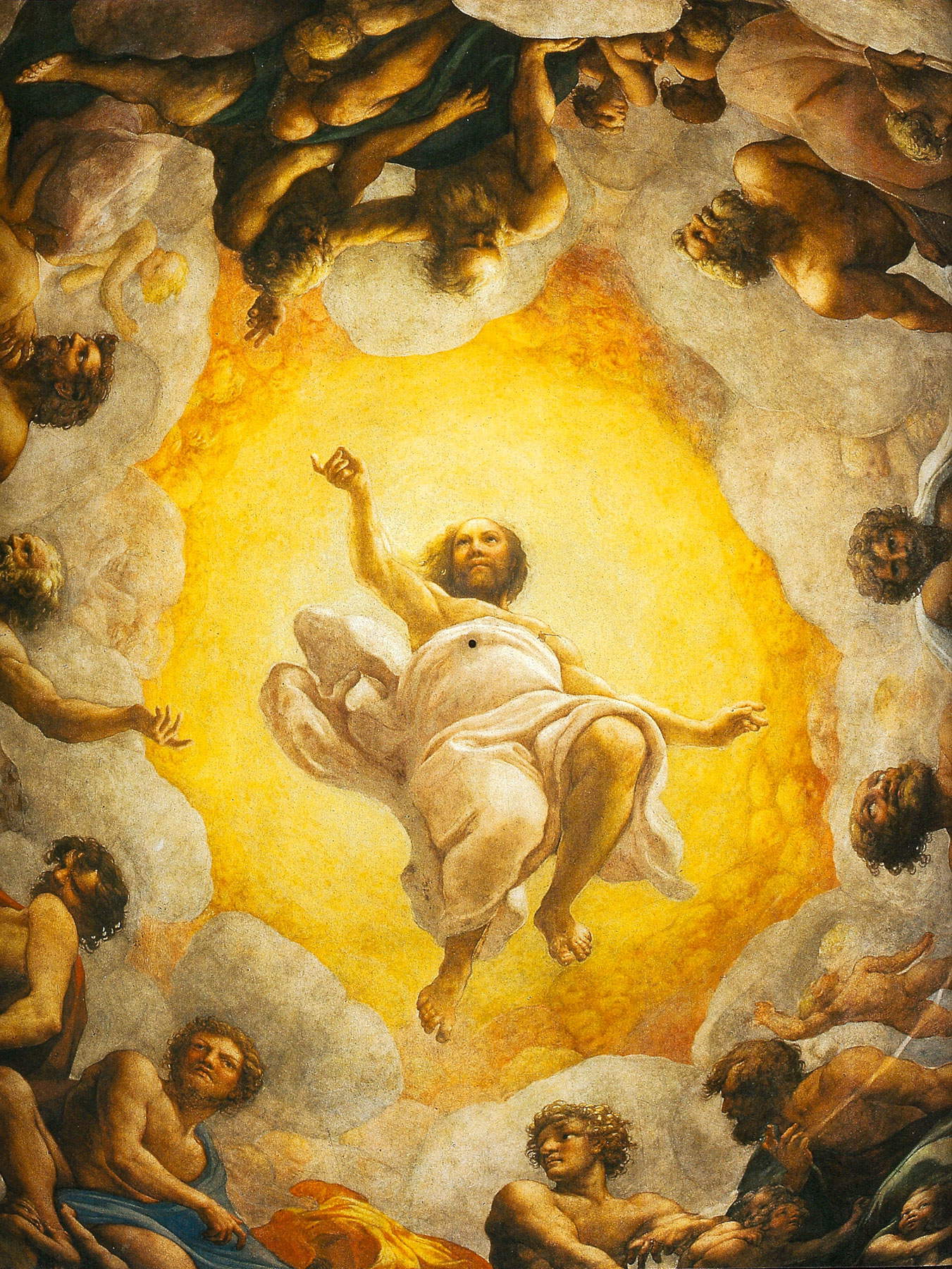 |
| Correggio. The central part of the dome of the Basilica of St. John. It is a vision of glory. Here truly the supreme Byzantine theophany of the φάο�? άσκοπο�? (the splendor without limits) is brought back to the Heavenly Jerusalem where no star but God himself is total, universal light. As Raphael in the Transfiguration touched this limit in the circumfused light, so Correggio explodes it in the unreachable light of the divine seat. |
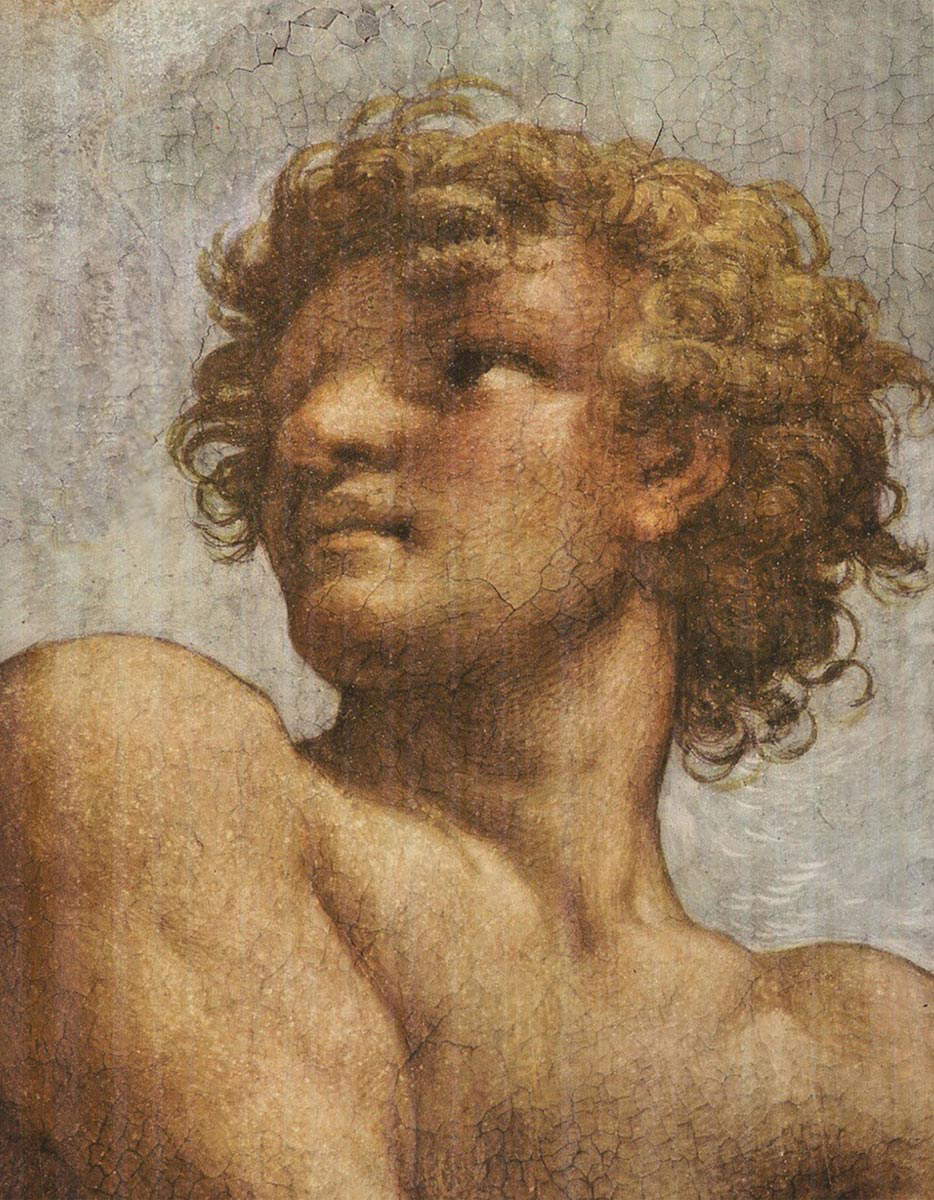 |
| Correggio. Detail from the dome of San Giovanni Evangelista in Parma. We see the intense, capacitating, serene face of James of Alphaeus looking up at his Lord. This figure is symbolic of those new avenues of figuration that its author, Antonio da Coreggio, has now opened up for all eveniente Western painting. |
We thus want to return to the reason for this artistic meditation. The three greats of the Renaissance (Leonardo, Michelangelo and Raphael) leave a very rich cosmographic legacy, which surfaces in human expressions in courtly or dramatic forms, but still suspended on the question of eternity. Correggio, the youngest, is the one who plunges into eternity by solving ideational and executive problems that regenerate in this dome all Italian painting on the trembling acme of a creative continuation that seemed impossible. It is the dome of San Giovanni that is the admirable document of this vital transition, where history and presence, image and motion, latitude and space, light and conscious emotion, together decline the new verb of art.
Now, when even minor and sought-after anniversaries are celebrated everywhere, the city of Parma (capital of Italian culture for a year, but world capital forever of Correggio, that is, of the palingenesis of the art of the West) must realize a Fifth Centenary that is of incomparable importance and that stands out in the universal history of art. Parma must realize what artistic heritage it holds if it wants to show itself as “capital.”
Warning: the translation into English of the original Italian article was created using automatic tools. We undertake to review all articles, but we do not guarantee the total absence of inaccuracies in the translation due to the program. You can find the original by clicking on the ITA button. If you find any mistake,please contact us.